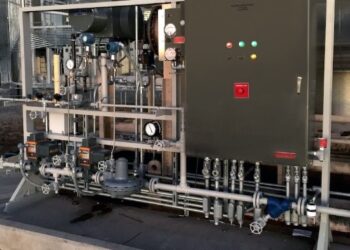Control and Safety Systems
Control systems
process control systems (PCS)
sometimes called industrial control systems (ICS), function as pieces of equipment along the production line during manufacturing that test the process in a variety of ways, and return data for monitoring and troubleshooting.


Programmable logic controller
A programmable logic controller (PLC) or programmable controller is an industrial digital computer that has been ruggedized and adapted for the control of manufacturing processes, such as assembly lines, robotic devices, or any activity that requires high reliability, ease of programming, and process fault diagnosis.
supervisory control and data acquisition (SCADA) system
Supervisory control and data acquisition (SCADA) is a control system architecture comprising computers, networked data communications and graphical user interfaces (GUI) for high-level process supervisory management, while also comprising other peripheral devices like programmable logic controllers (PLC) and discrete proportional-integral-derivative (PID) controllers to interface with process plant or machinery.

Management systems (MIS,PIMS,LMS,MES)
Management Systems are systematic frameworks designed to manage an organization’s policies, procedures and processes and promote continual improvement within.

Thermal automation systems(TAS)
TAS provides monitoring, control and management of the entire product handling process from receiving to storage to distribution.
Safety instrumented systems (SIS)
Fire and gas (F&G) systems
A F&G safety system continuously monitors for abnormal situations such as a fire, or combustible or toxic gas release within the plant; and provides early warning and mitigation actions to prevent escalation of the incident and protect the process or environment.

Safety shutdown systems(SSS)

The safety shutdown system (SSS) shall shut down the facilities to a safe state in case of an emergency situation, thus protecting personnel, the environment and the asset. … This system might also be fed by signals from the main fire and gas system.
emergency shutdown (ESD)systems
For critical equipment
Burner management systems(BMS)
A Burner Management System or BMS is a safety system used to assure safe start-up, operation and shut down of process burners.
Subsea monitoring/control systems
Compressors control systems



high-integrity pressure protection systems (HIPPS)
A high-integrity pressure protection system (HIPPS) is a type of safety instrumented system (SIS) designed to prevent over-pressurization of a plant, such as a chemical plant or oil refinery.
monitoring systems
Conditioning monitoring systems (CMS) , including vms , tms, cvms
Condition monitoring systems (CMS) evaluate the vibration data and determine the condition of the machine based on the analysis of amplitude and frequency.
Integrated system for vibration monitoring of rotating equipment
Fiber optic pipeline integrity monitoring systems
Tank gauging means liquid measurement in large storage tanks to determine product volume. Rosemount Tank Gauging System ensures accurate level, temperature, and pressure measurements for inventory control, oil movement and overfill prevention, securing efficient operations.
Building monitoring systems
A Building Management System (BMS) also known as a building automation system (BAS) is a computer-based control system installed in buildings that controls and monitors the building’s mechanical and electrical equipment such as ventilation, lighting, power systems, fire systems, and security systems
Valve remote control system (VRCS)
The Valve Remote Control System (VRCS) is considered by the “International Convention for the Safety of the Life at Sea” (SOLAS) to be critical for the safety of passengers, crew and transported cargo on any type of ship, whether on commercial ships, cruise vessels, chemical carriers, LNG, LPG, and even FPSOs.


Remote terminal units(RTU)
A remote terminal unit (RTU) is a microprocessor-controlled electronic device that interfaces objects in the physical world to a distributed control system or SCADA (supervisory control and data acquisition) system by transmitting telemetry data to a master system, and by using messages from the master supervisory system to control connected objects.


